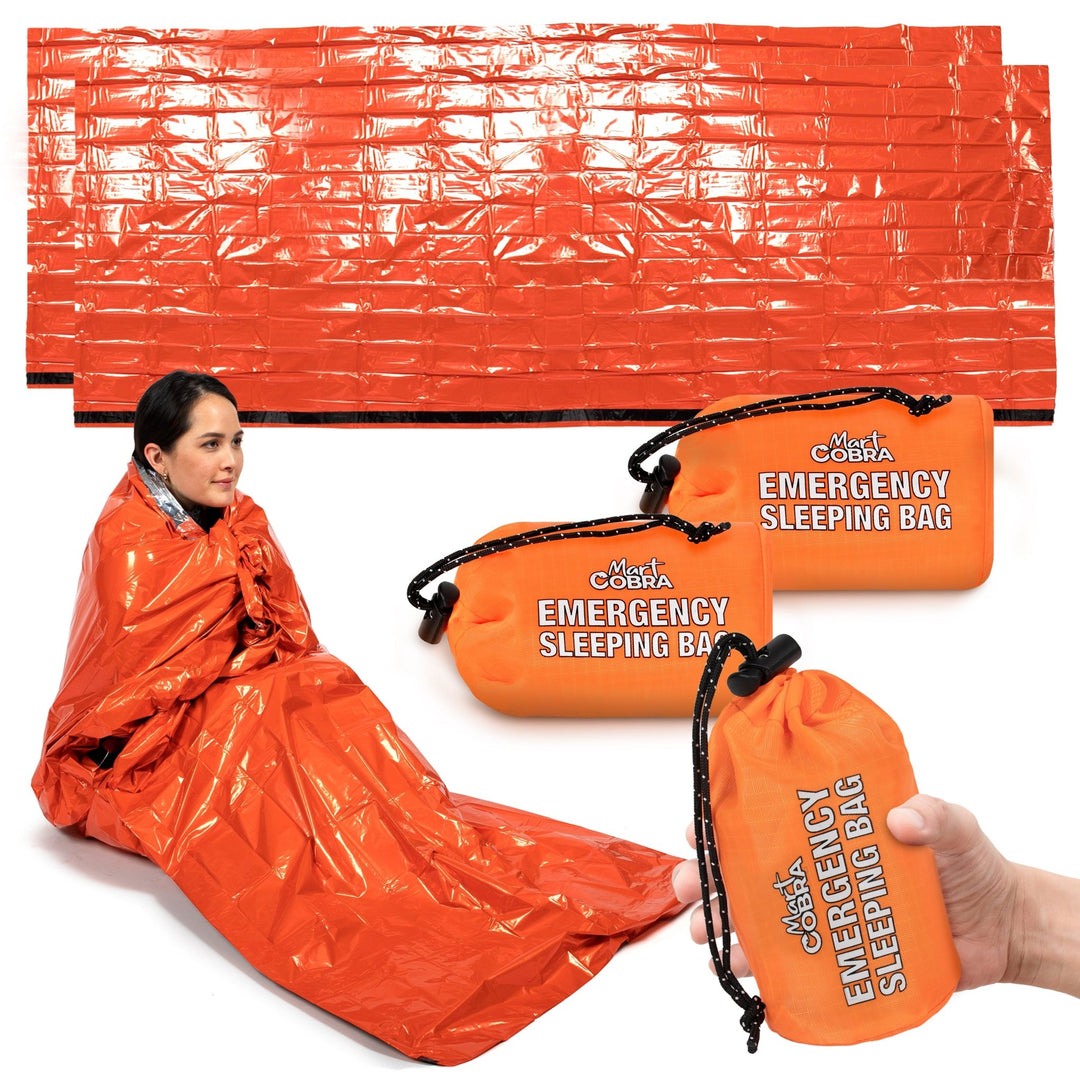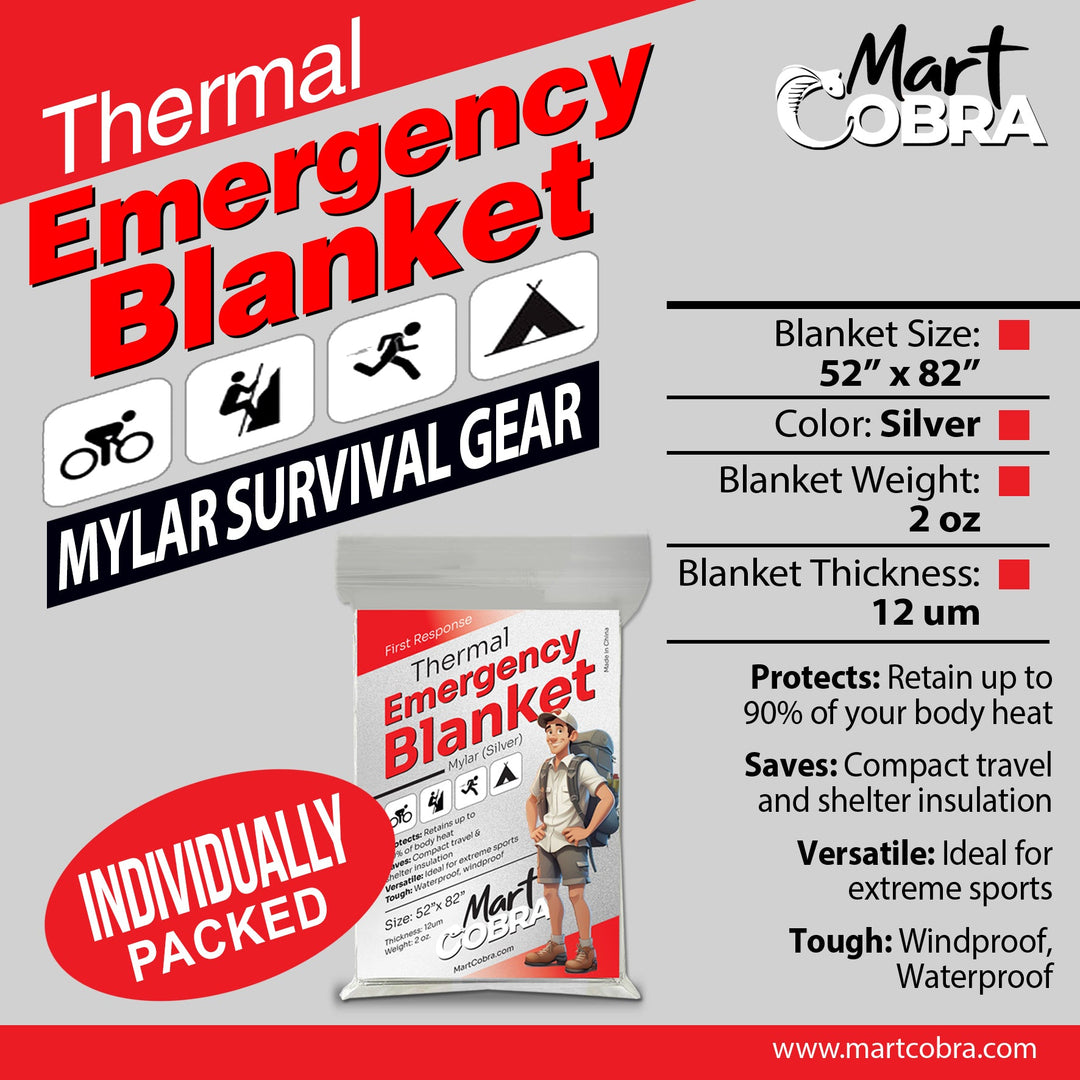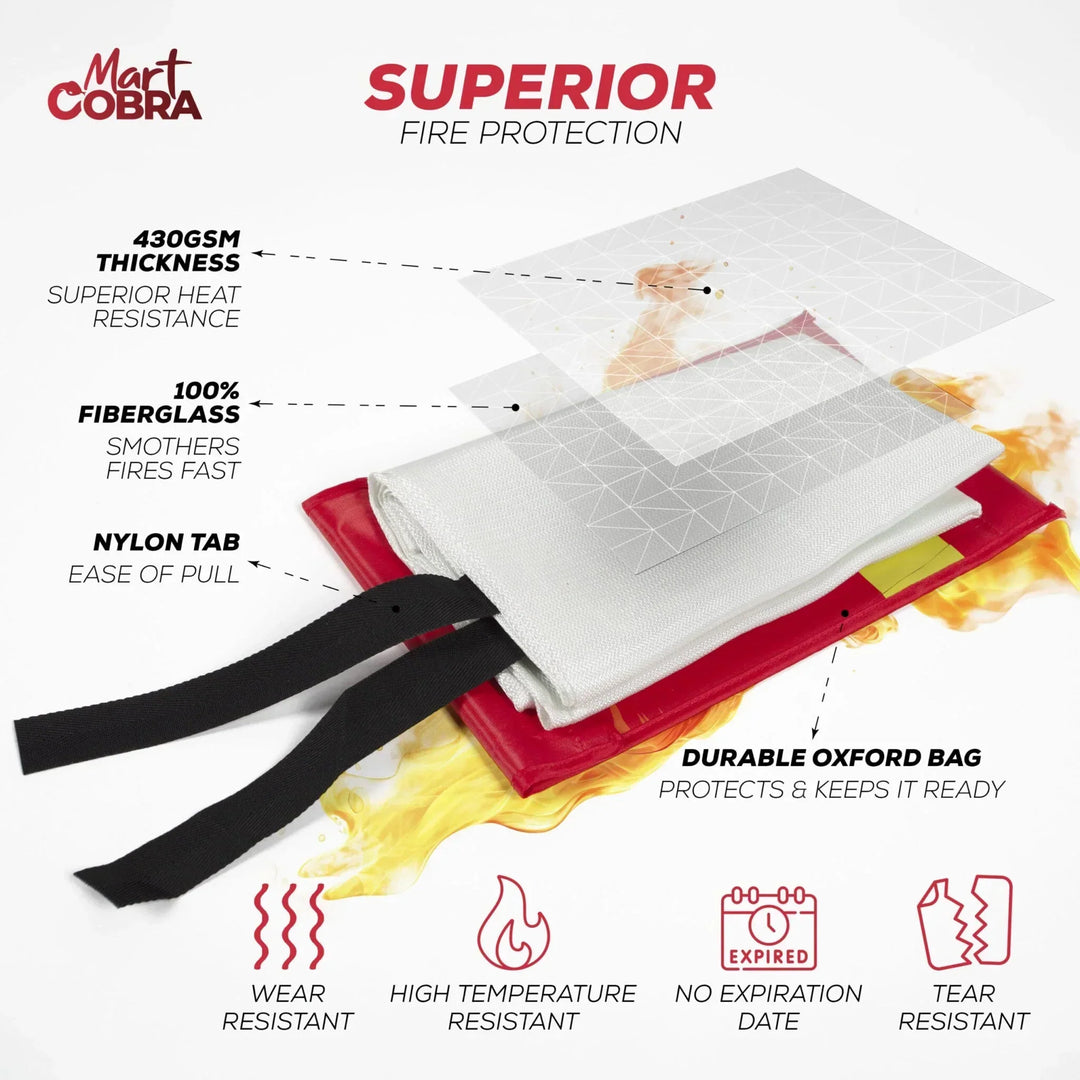Fire safety is a crucial consideration for everyone, whether you're a homeowner, a camping enthusiast, or an advocate of emergency preparedness. While we often think about fire extinguishers as our first line of defense,fire blankets are a relatively underappreciated yet vital tool for smothering unexpected flames.
In this comprehensive guide, we will explore the unsung hero of fire safety, the fire blanket, and why it's a must-have in your home, workshop, or backpack. From understanding what a fire blanket is to learning the specifics of selection and use, this guide will prepare you for unexpected fire emergencies.
What is a Fire Blanket?
A fire blanket is a safety device designed to extinguish small fires. It consists of a sheet made from fire-resistant materials like fiberglass or wool which is treated with a fire-retardant chemical.
Fire blankets are particularly effective for kitchen fires or for situations where someone’s clothing catches fire. Unlike fire extinguishers that can spread the burning grease or oil, fire blankets don’t create a mess and are simple to use.
How Do Fire Blankets Work?
The fire blanket acts as a heat shield. It smothers the flames by cutting off the oxygen supply.Oxygen is one of the three elements necessary for a fire to burn. The other two elements are heat and fuel (which is why it's essential to keep flammable materials away from your fire blanket).
When thrown over a small fire, the blanket creates a seal around the flames, suffocating them and preventing them from spreading. Fire blankets are specially designed to not catch fire themselves, due to their durable material and fire-resistant coating.
What is a Fire Blanket Made Of?
Typically, fire blankets are crafted from materials known for their resistance to flames and high temperatures. The most commonly used materials include fiberglass, wool, and silica.
Fiberglass
Fiberglass is a popular choice due to its durability, fire resistance, and affordability. It is composed of fine fibers of glass and does not burn or easily conduct heat, making it an excellent option for fire blankets.
Fire blankets made from fiberglass can withstand temperatures up to 1000 degrees Fahrenheit and can provide protection against most small fires without deteriorating.
Wool
Wool is a natural fiber known for its fire-resistant properties. When treated with fire-retardant chemicals, wool's resistance to flames is significantly enhanced.
Additionally, wool fire blankets are advantageous because wool can also act as an insulator against heat. This means that wool blankets not only suppress flames but can also help protect users from the heat of a fire.
Silica
For environments or situations that demand even higher levels of fire protection, silica-based fire blankets are an option.
Silica, a component derived from quartz, can endure temperatures up to 1800 degrees Fahrenheit when woven into fabric form. This makes silica fire blankets suitable for extreme heat scenarios. It offers better protection by resisting melting or burning at temperatures that would compromise materials like fiberglass or wool.
In addition to these materials, some fire blankets may also be treated with fire-retardant chemicals to enhance their flame resistance further. These chemicals help ensure that the blanket can keep smothering fires and fires effectually without itself becoming a fuel source.
The combination of these materials and treatments makes fire blankets a reliable safety tool in extinguishing flames or acting as a barrier against heat and fire.

Why is Asbestos Not Used in Fire Blankets Anymore?
Once praised for its remarkable fire resistance,asbestos was widely used in producing fire blankets. However, its usage has ceased due to the severe health dangers it poses.
Extensive research has firmly established the link between asbestos exposure and grave respiratory illnesses such as asbestosis, lung cancer, andmesothelioma. In response to these substantial health risks, regulatory bodies globally have implemented stringent bans and guidelines, effectively halting the use ofasbestos in fire blankets, clothing, and other consumer goods.
Do I Need a Fire Blanket?
The short answer is yes. Whether you’re in a private or commercial setting, having a fire blanket on hand can be a lifesaver. Here are key scenarios where it's indispensable:

For Home and Kitchen Safety
Fire safety in the kitchen is of paramount importance. A fire blanket can put out small stovetop fires by smothering the flames, allowing you to avoid the hazards of a traditional water or extinguisher method that can spread the fire further.
Essential for Camping and Outdoors
When enjoying the great outdoors, having a fire blanket can be the difference between a controlled campfire and a dangerous forest fire. It's an excellent backup safety item that's lightweight and easy to carry and use, making it an invaluable addition to your camping gear.
Emergency Preparedness
For those who takeemergency planning seriously, a fire blanket is indispensable. In an unforeseen fire event where escape routes are cut off, a fire blanket can provide a few critical moments of protection.
Do firefighters use fire blankets?
Fire blankets are primarily meant to distinguish small fires, but they are also utilized by firefighters. They're integrated into firefighting gear to protect from heat and flames, especially in situations like rescuing people from burning buildings or vehicles.
Benefits of a Fire Blanket
Aside from being an effective tool in suppressing fires, fire blankets offer several other benefits. These include:
- Ease of Use: Unlike fire extinguishers that may require some training to use correctly, fire blankets are straightforward and can be deployed quickly by almost anyone.
- Versatility: Fire blankets can be used on a variety of fire types, especially small fires that can occur in the kitchen, camping sites, or any other environment. They are effective in liquid and electrical fires where water cannot be used.
- Safety: A fire blanket safely contains a fire, preventing it from spreading, unlike water or improper fire extinguisher use, which can escalate the situation.
- Reusability: Some fire blankets are designed to be reusable, making them a cost-effective option for fire safety as long as they are not damaged.
- No Cleanup Required: After a fire has been extinguished using a fire blanket, there is no residue or mess to clean up, unlikechemical fire extinguishers that leave behind a residue.
- Compact and Portable:Most modern fire blankets are lightweight and easy to store, making them ideal for home use or on-the-go situations.
When Should You Use a Fire Blanket?
A fire blanket should be used in the early stages of a small fire. Here are some instances where its use is appropriate:
- When clothing or hair catches on fire
- To smother small electrical fires, such as from appliances or outlets
- To extinguish stovetop cooking fires
- To suppress small liquid fires, such as from oil or grease

How to Use a Fire Blanket?
Deploying a fire blanket is a straightforward process, but knowing how to use it effectively is critical. Here's a step-by-step guide on how to use a fire blanket:
Step-by-Step Guide
-
Stay Calm: In challenging situations, staying calm is key to making quick and rational decisions.
-
Assess the Situation: Before deploying a fire blanket, assess the size of the fire and make sure it is still small enough for you to handle safely. If it's too large or spreading, evacuate immediately.
-
Retrieve the Fire Blanket: Locate the nearest fire blanket. Fire blankets are often stored in designated areas such as kitchens, workshops, or near fire extinguishers.
-
Cover Yourself: If possible, cover yourself with protective clothing and make sure that any flammable items are removed from the premises.
-
Release the Fire Blanket: Fire blankets are usually kept in a pouch designed for quick release. Simply pull the two tabs located at the bottom of the pouch to release the blanket.
-
Unfold the Blanket Correctly: Hold the corners of the fire blanket and unfold it completely. Ensure that the entire surface of the fire blanket is ready to be deployed.
-
Approach the Fire: Carefully approach the fire, but maintain a safe distance. Do not put yourself in danger by getting too close to the flames.
-
Cover the Fire: Start from the nearest edge and gently lay it across, covering the fire completely. Be careful to keep your hands behind the blanket to avoid exposure to heat or flames. If the fire is in a container, such as a pot, try to seal the fire within by covering the container's opening fully.
-
Turn Off the Heat Source (if possible): If the fire is caused by a heat source such as a stove or electrical appliance, turn off the heat source if it is safe to do so. This helps prevent the fire from reigniting.
-
Leave the Blanket in Place: Once the fire is extinguished, leave the fire blanket in place for several minutes to ensure that the flames do not reignite. Do not attempt to remove the blanket too quickly.
-
Monitor the Area: Keep an eye on the area to ensure that the fire does not flare up again. If necessary, seek assistance from professional services or evacuate the area if the fire is out of control.
- Dispose of the Fire Blanket Safely: Once the fire is completely extinguished and the area is safe, carefully fold the fire blanket and dispose of it according to local regulations. Some fire blankets may be single-use, while others can be reused after cleaning and inspection.
Remember, using a fire blanket requires caution and awareness of safety protocols. If the fire is too large or out of control, evacuate the area immediately and get help.
Types of Fire Blankets
There are several types of fire blankets available, each designed for different fire hazards. The most common types include:
Fiberglass Fire Blankets
Made from a dense, flexible, and heat-resistant fiberglass fabric, these blankets are most common in kitchens and laboratories where small fires are likely. They can withstand temperatures up to 1,000 degrees Celsius.
Wool and Treated Wool Fire Blankets
Wool naturally resists flames and, when treated with flame-retardant chemicals, becomes even more effective in fighting fires. These blankets are heavier, adding an extra level of smothering capability.
Welding Fire Blankets
Welding fire blankets are specifically designed to withstand the high temperatures generated during welding or cutting operations. They are often made from materials like fiberglass with additional heat-resistant coatings.
Fire Blankets for Electrical Fires
These fire blankets are made with materials that are safe to use on electrical fires. They are non-conductive and can smother flames without conducting electricity. They are suitable for extinguishing fires involving electrical equipment.
Oil and Grease Fire Blankets
Fire blankets designed for oil and grease fires are made from materials that can withstand the intense heat produced by burning oils and fats. They are commonly used in kitchens and industrial settings where cooking oil or grease fires may occur.

Chemical Resistant Fire Blankets
Designed for specific types of chemical fires, such as those in laboratories or industrial settings, these blankets can suppress flames without reacting to the chemicals involved in the fire.
High-Temperature Fire Blankets
High-temperature fire blankets are designed to withstand extreme heat and are often used in industries such as foundries, steel mills, and glass manufacturing plants where fires can reach very high temperatures.
Emergency Escape Fire Blankets
Smaller, more portable fire blankets designed for outdoor activities, caravans, and small kitchens. They are easy to store and quick to deploy in emergencies.
Fire Blankets for Vehicles
These fire blankets are specifically designed for use in vehicles, such as cars, trucks, boats, and aircraft. They are compact and often come with mounting brackets for easy storage and quick access in case of emergencies.
Choosing the Right Fire Blanket
Now that you know the different types of fire blankets available, choosing the right one for your needs is essential. Consider the following factors whenselecting a fire blanket:

Factors to Consider When Choosing a Fire Blanket
-
Intended Use: First and foremost, identify the potential fire hazards within your environment. The type of blanket you need will depend on what kinds of fires are most likely to occur in the area where it will be kept.
-
Size and Coverage: Determine the appropriate size of the fire blanket needed based on potential fire hazards in the area. Larger blankets cover more area but may be more difficult to handle.
-
Temperature Rating: Check the maximum temperature the fire blanket can withstand. This is especially important in environments where fires can reach exceptionally high temperatures.
-
Material Composition: The material of the fire blanket affects its performance and suitability for different types of fires. For example, fiberglass blankets are common for general home use, but for specific hazards like chemical or electrical fires, look for specialized materials.
-
Storage and Accessibility: Consider how the fire blanket will be stored and ensure it is easily accessible. Some blankets come with storage solutions that can be mounted in convenient locations.
-
Ease of Use: Look for a fire blanket that is easy to deploy. Quick-release pouches or mounting brackets can make it easier to access the fire blanket quickly when needed.
-
Certifications and Standards: Ensure the fire blanket meets local and international safety standards and certifications. This guarantees the blanket's effectiveness and reliability.
-
Reusable vs. Disposable: Decide whether you need a reusable fire blanket that can be used multiple times or a disposable one. Reusable fire blankets may require cleaning and maintenance, while disposable blankets offer convenience but are designed for single use only.
-
Price vs. Quality:While affordability is a factor, it should not be the sole criterion. Investing in a high-quality fire blanket can offer better protection and longer service life.
- Manufacturer's Reputation and Warranty:Choose a fire blanket from a reputable manufacturer likeMart Cobra that offers a warranty or guarantee. This can provide peace of mind and ensure support in case of defects or issues.
Standards and Certifications for Fire Blankets
When purchasing a fire blanket, it is essential to check for proper certifications and standards as they ensure the quality and effectiveness of the product. Look for the following certifications when selecting a fire blanket:
-
British Standards: In the UK, look for fire blankets that are certified by the British Standard Institution (BSI) and meet BS EN 1869:1997 standards.
-
European Standards: In Europe, fire blankets should meet the EN 1869:1997 standard and be CE-marked.
-
Australian Standards:Fire blankets in Australia should be certified by the Australian Standard AS/NZS 3504:2006.
-
American Standards: Look for fire blankets that areUL-certified and comply with NFPA standards in the USA.
-
International Standards: The International Organization for Standardization (ISO) has set standards and requirements for fire blankets, including ISO 1869:2017.

Fire Blanket Maintenance and Replacement
A fire blanket is a safety tool that should be regularly maintained and replaced when necessary to ensure its effectiveness in emergencies. Follow the tips below to keep your fire blanket in good working condition.
Regular Inspection
Check the fire blanket periodically for any signs of damage, discoloration, or wear and tear. To ensure your fire blanket remains in optimal condition and ready for use at any time, follow these steps for a thorough inspection:
-
Visual Inspection: Begin by visually examining the fire blanket for any signs of physical damage, such as tears, holes, or burns. Also, check for discoloration or moisture, which could indicate deterioration.
-
Check for Accessibility:Verify that the fire blanket is stored in an easily accessible location and that its storage case or container is not blocked by any objects.
-
Inspect theSeals: If the fire blanket is stored in a tamper-evident container, check that the seals or tamper indicators have not been broken. A broken seal can indicate use or tampering.
-
Review the Expiry Date: Look for an expiry date or manufacture date. While many fire blankets do not have a specific "use by" date, the material can degrade over time. If the blanket is more than the recommended years old, consider replacing it.
-
Read the Instructions: Ensure the fire blanket comes with clear instructions for use. These should be legible and intact. If the instructions are missing or unreadable, it might be time to replace the blanket.
-
Ensure Handles are Intact: For fire blankets equipped with tabs or handles (for pulling the blanket out of its container), check that these are securely attached and in good condition.
-
Folding Verification (If Applicable):If you have had to unpack and repack the fire blanket for any reason, confirm that it has been folded correctly according to the manufacturer's instructions.
-
Packaging Condition:Assure the container or packaging doesn't show signs of excessive wear or damage that could affect the accessibility or protection of the blanket.
- Check Mounting Hardware: If the fire blanket is wall-mounted, inspect the bracket or hook to ensure it is secure, and the blanket can be quickly and easily removed if needed.
If any damage or wear is found during inspection, it's crucial to replace the fire blanket to ensure proper functionality in case of a fire.
Maintenance
Proper maintenance of your fire blanket is crucial for ensuring its reliability and effectiveness. Follow these maintenance guidelines to keep your fire blanket in optimal condition:
-
Clean Gently AfterUse: If your fire blanket gets dirty and is not needed for a single-use scenario, clean it according to the manufacturer's instructions. Usually, gently wiping with a damp cloth is sufficient. Avoid using harsh chemicals or detergents that can damage the blanket's fire-resistant material.
-
Dry Before Repacking: After cleaning or any exposure to moisture, ensure the fire blanket is completely dry before repacking it into its container. Storing a damp blanket can lead to mold and weaken the material's integrity.
-
Follow Manufacturer's Guidelines for Reuse: If the fire blanket is designed for multiple uses, read and follow the manufacturer's guidelines for cleaning, refolding, and repacking the blanket. Not all fire blankets are suitable for repeated use after being exposed to high temperatures or flames.
-
Store Properly: Always store the fire blanket in its original container or pouch provided by the manufacturer. This storage should be kept in a known, easily accessible location that is free from obstructions, ensuring quick access.
-
Avoid Unnecessary Handling:To prevent damage, avoid frequent unpacking or unnecessary handling of the fire blanket. Keep it sealed in its packaging until required for use or inspection.
-
Training:Ensure that family members or employees know the fire blanket's location and are trained on how to use it correctly. Familiarize yourself with the deployment technique to avoid panic during an actual fire situation.
- Professional Inspection:For commercial settings or if the fire blanket is part of critical safety equipment in a facility, consider having a professional safety inspector check the blanket periodically. This can be part of a broader fire safety inspection routine.
By adhering to these maintenance practices, you can significantly extend the lifespan of your fire blanket and maintain its effectiveness in protecting against fires.

Replacement Schedule
Most fire blankets need replacement after use or if they have undergone significant stress or damage. Check the manufacturer's recommendations for the expected lifespan of your specific fire blanket. However, here are some general guidelines to follow:
- After use – Replace immediately if the fire blanket was used to smother a fire.
- Every 10 years – Even if unused, consider replacing after ten years of storage due to material degradation.
- If showing signs of damage or wear before the recommended time frame. Regular maintenance and inspections can help detect these issues early on.
- If the expiry date has passed - Some fire blankets come with an expiration or manufacture date. Follow the manufacturer's instructions for replacement when this date is reached.
Regular maintenance, proper use, and timely replacements are essential to ensure your fire blanket's reliability in case of emergencies. With a well-maintained fire blanket, you can have peace of mind knowing you have a reliable tool for protecting against fires.
Note: It is important to note that fire blankets are not meant to replace other necessary fire safety equipment such as smoke detectors, fire extinguishers, and evacuation plans. They should be used as an additional layer of protection in case of a small, contained fire.
How to Store a Fire Blanket?
Storing your fire blanket correctly is crucial. It should be in optimal condition and readily accessible when needed. Follow these guidelines for proper storage:
-
Easily Accessible Location: Choose a storage location that is easily accessible and known to all household members or employees. Ideal locations include near the kitchen, in hallways close to potential fire sources, or near exits.
-
Visible and Unobstructed:Ensure the storage spot is visible and not obstructed by furniture or other items. The fire blanket should be within arm’s reach without the need to move obstacles.
-
Original Packaging: Always keep the fire blanket in its original container or pouch that comes with clear instructions for use. These containers are designed to protect the blanket from damage and allow for quick deployment.
-
MountSecurely:If possible, wall-mount the fire blanket’s container using the brackets provided. This keeps the blanket off the ground, preventing moisture absorption and potential damage.
-
Avoid HeatSources: While it might seem logical to store a fire blanket near a stove or heater (common fire sources), ensure it is not in direct contact with high temperatures that could degrade the material over time.
-
DryEnvironment:Store the fire blanket in a dry environment to prevent mold growth and material degradation. Avoid areas prone to dampness or water leaks.
-
Instruction Accessibility:Keep the usage instructions easily accessible and intact. Consider practicing the deployment of the fire blanket (if it can be repacked) to ensure everyone knows how to use it.

Important Precautions When Using Fire Blankets
When using a fire blanket, it's important to take certain precautions to optimize safety and effectiveness. These precautions include:
-
Assess the Fire:Before attempting to use a fire blanket, quickly assess the size and type of fire. Fire blankets are most effective on small, contained fires. If the fire is too large or spreading rapidly, evacuate immediately and get help.
-
Protect Yourself: Always ensure your hands, body, and face are protected. If possible, wrap the edges of the fire blanket around your hands to shield them from heat and flames when covering the fire.
-
Do Not Fan the Flames: Gently place the fire blanket over the flames to smother them; avoid throwing or fanning the blanket onto the fire, as this could introduce more oxygen to the flames, potentially causing the fire to grow.
-
Leave the Blanket in Place:Once you have successfully covered the fire, do not attempt to move or lift the fire blanket until you are certain the fire is completely extinguished. This may take several minutes.
-
Evacuate if Necessary: If the fire does not go out, or if the situation becomes too dangerous, evacuate the area immediately. Your safety is more important than the property or the blanket itself.
-
Get Help: Even if the fire seems to be extinguished, it's advisable to call professional services for a safety check. Hidden embers could reignite the fire.
-
Use on People: If a person’s clothing catches fire, have the person stop, drop, and roll to extinguish the flames. You can then wrap them in the fire blanket, taking care to cover the flames completely while avoiding suffocation. Always call for medical help in such instances.
-
Breathing Apparatus Usage: If the fire blanket is used within a confined space, it's crucial to use proper breathing apparatus as the blanket can smother oxygen and cause suffocation.
-
Check for Heat: After you believe the fire has been extinguished, carefully touch the blanket edges to ensure there is no heat emanating before removing it. Some materials can hold heat and reignite upon exposure to air.
- One-time Use:Remember that most fire blankets are designed for single use only. Once a fire blanket has been used to extinguish a fire, it should not be reused, even if it appears to be undamaged. Dispose of it properly and replace it with a new one.
Role of Fire Blankets in Regular Fire Safety Drills
The importance of regularly practicing fire safety drills cannot be overstated, as these drills prepare individuals and groups for real-life scenarios. Moreover, including fire blankets in these drills is crucial for several reasons.
Firstly, it familiarizes users with the blanket's location and the mechanics of its operation and deployment.
Secondly, it helps individuals understand the importance of acting quickly and independently to minimize the potential spread of a fire.
Lastly, regular drills can help prevent any confusion or panic in case of a real fire.
Remember, while using a fire blanket may seem straightforward, practicing beforehand can make all the difference. Regular drills also allow for feedback and room for improvement in safety procedures.

FAQs
Q. What is a fire blanket used for?
A fire blanket is a safety device designed to extinguish small fires by smothering them with a non-flammable material.
Q. Can a fire blanket be reused?
In most cases, no. Fire blankets are designed for one-time use and should not be reused even if they appear undamaged. This is because the material may have been weakened or compromised during the first use, reducing its effectiveness in future emergencies.
Q. What types of fires can be extinguished with a fire blanket?
Fire blankets are most effective on small, contained fires such as those on stovetops or clothing. They may not be suitable for larger or rapidly spreading fires.
Q. How do you use a fire blanket in an emergency?
To use a fire blanket, quickly assess the size and type of fire, and protect yourself by covering your hands, body, and face. Then, place the blanket over the flames to smother them while avoiding fanning or throwing it onto the fire. Leave it in place until you are certain the fire is completely extinguished and call for help.
For more detailed instructions, consult the manufacturer's guidelines.
Q. Where should fire blankets be stored?
Fire blankets should be stored in an easily accessible location, preferably near potential fire hazards such as stovetops or fireplaces. They should also be kept away from heat sources and not be obstructed by other objects to ensure quick deployment.
Q. Can you touch a fire blanket?
After a fire has been extinguished, it's important to check for heat before touching the blanket. Some materials can hold heat and reignite upon exposure to air. If there is no heat emanating from the blanket, it can be carefully touched and removed for disposal. Always use caution when handling a fire blanket that has been used to smother flames.
Q. What can a fire blanket not be used for?
Fire blankets should not be used to smother large or rapidly spreading fires, as this can put the user in danger. They also should not be used on electrical fires or grease fires, as these require specific fire-fighting methods. Always assess the type and size of a fire before attempting to use a fire blanket.
Q. Can a fire blanket protect you?
Fire blankets are designed to protect against small, contained flames and can be used to smother clothing fires on a person. However, they should not be relied upon as the sole means of protection.
Q. How do I dispose of a used fire blanket?
Used fire blankets should be disposed of properly according to local regulations and guidelines. They may need to be placed in a fire-proof container or taken to a designated disposal site. Check with your local authorities for specific instructions on how to dispose of a used fire blanket.
Q. Can I use a fire blanket if I have no training?
While it's always recommended to receive proper training in fire safety and how to use a fire blanket, they can still be used without prior training.
However, familiarizing yourself with the blanket's location and deployment process can help reduce panic and increase efficiency. It is also important to check the manufacturer's guidelines for specific instructions on how to use their fire blanket.
Additionally, taking a fire safety course can provide valuable information and training on how to use a fire blanket and other fire-fighting equipment.
Q. How long do fire blankets last?
Fire blankets do not have an expiration date but should be replaced if they show any signs of damage or wear. With proper care and maintenance, fire blankets can last for several years. However, it's important to always follow the manufacturer's recommendations for replacing fire blankets.
Q. Which kind of fire blanket do I need?
There are different types of fire blankets available, each designed for specific purposes and fire types. It's important to choose a fire blanket that is appropriate for the potential hazards in your home or workplace. Consult with a fire safety expert or refer to the manufacturer's guidelines for guidance on which type of fire blanket is best suited for your needs.
Conclusion
Fire blankets are an important safety tool that can help prevent small fires from growing into dangerous situations. By understanding their purpose, proper usage, and storage, individuals can be better equipped to handle fire emergencies and protect themselves from harm. It's recommended to regularly check and maintain them to ensure they are always ready for use
Remember, fire blankets are just one component of a comprehensive fire prevention and safety strategy. Alongside functional smoke alarms and an evacuation strategy, understanding how to use other fire-fighting equipment is crucial. By staying informed and vigilant, we can prevent fires and keep ourselves and our communities safe!







